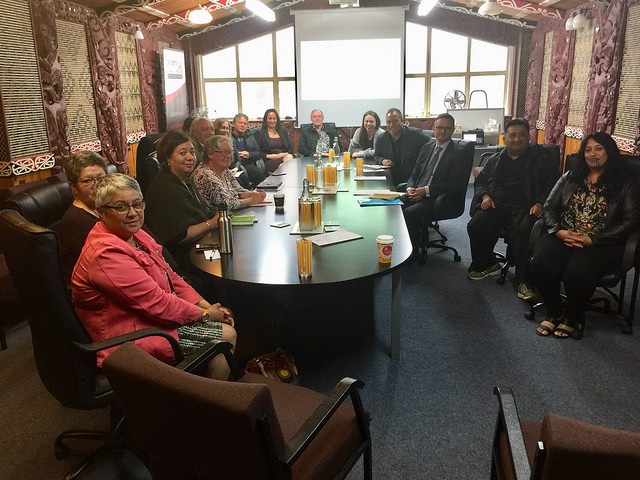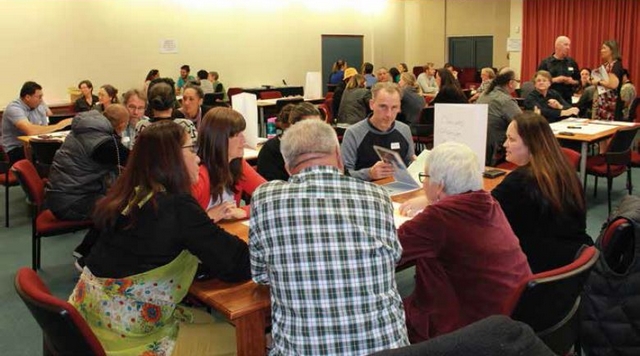Te Arawa tackle climate change

A sudden crash around midday on 5 January 2018 shocked residents at Mourea into thinking they’d experienced an earthquake. But it was the sound of a 10 m tree falling onto the kitchen and dining room of the nearby Taupari Marae on the northern edge of Lake Rotorua. The intense storm that brought the tree down was similar to a category 2/3 tropical cyclone. For Ngāti Parauharanui – the people of Taupari Marae – all they could do was stand by and watch as their marae; their refuge and the safe place of their stories and their tipuna, was lashed by wind and rain. Protecting marae with insurance is a $20 k annual bill, but their true value is well beyond a monetary figure.
The same storm caused problems elsewhere for Te Arawa iwi. Rain, nine metre waves and a huge king tide created a deluge of water that battered Little Waihi. It was the worst in a series of three storms that had assaulted the small eastern Bay of Plenty community and wet the floor of their homes with sea water.
Four months later, in April, another storm raged over Rotorua with rainfall so intense it became the catchment’s wettest hour ever recorded. The rainfall caused the Awahou Stream to breach its banks and flood the homes of many Te Arawa whānau living in low lying areas of Ngongotaha. The cost of fixing the damage is in the realm of $21.2 m.
These incidents are not just frightening one-off experiences anymore, they are warnings of what climate change will bring. Their devastating destruction could be just a taste of what is to come.
But an enterprising spirit is strong in the people of Te Arawa, who have begun to prepare for climate change through Te Urunga o Kea: Te Arawa Climate Change Working Group, initiated by Te Arawa Lakes Trust (the Trust). The Trust partnered with Scion to support the successful application from Te Urunga o Kea to the Ministry for Business, Innovation and Employment’s Te Pūnaha Hihiko: Vision Mātauranga Capability Fund to work with Scion to co-develop a Te Arawa Climate Change Strategy.
Co-developed research
Te Urunga o Kea is made up of individuals from Te Arawa who are interested in climate change. They are a varied group who work in different industries, have unique experiences, different concerns and interests. This panel of iwi members also have representatives from Te Arawa Primary Sector and Te Arawa River Iwi Trust, and together they guide the research focus of the team working on the climate change strategy.
Te Arawa Lakes Trust Environment Manager, Nicki Douglas, says that they’re excited to tackle climate change, but they’re realistic. “At the end of the project, we want a strategy that identifies and addresses short, medium and long-term needs, and responds to the challenges and opportunities of climate change, using our mātauranga as the dataset along with other climate data.
She says, “The first phase of our strategy has to address the immediate needs of Te Arawa whānau and protecting our places; the second phase needs to look at the changes our mokopuna might encounter and the third stage should be multigenerational, looking far ahead. “We know we can’t do everything but guided by our working group and the wairua of our tipuna, we’ll address the major concerns of our people and look after our tamariki. We are a facilitator and a connector, and we’re here to bring the right people together.”
Challenges for Te Arawa
The rohe of Te Arawa is centred around Lake Rotorua, it stretches to Maketū in the east and to Tongariro in the South. Like all iwi across New Zealand, Te Arawa whanau face unique challenges brought about via climate change. But Te Arawa face other struggles that make adaption to climate change difficult – half of their population is under 23 and half of the working population earn less than the living wage ($42,744 pa). In light of this, they are considering climate change from an holistic point of view.
The research team led by Marie McCarthy with community researcher Lani Kereopa, has identified several concerns and opportunities that need careful thought. Beginning with the land – much of the whenua in the region is used for primary production and is vulnerable to climate change in many ways. Land use diversification will be key to economic survival and environmental sustainability. Issues like sea level rise will threaten coastal communities, marae and significant sites like pā and urupā. Other interests, such as food sovereignty, health, healthy housing, freshwater and energy independence have also been identified by their community as areas to explore. It is no small challenge ahead for the team, but a strength of this project is having been co-developed by Te Urunga o Kea and Scion, the project guidance is led by Te Urunga o Kea, ensuring research priorities stay connected to community needs.
Our next steps
The next steps for the research team and Te Urunga o Kea are to scope out and then to run hui around the rohe, talking to people and hearing about their experiences. They also hope to inspire other models from around the motu.
Project leader Marie McCarthy says, “We’d like this to be an example of how we can bring science and our community together – to make connections, realise commonalities and spark new collaborations that will really benefit our people.”
For further information on this project contact

